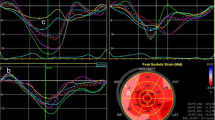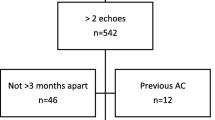Abstract
Background
Cardiac dysfunction associated with anthracyclines is a significant side effect of chemotherapy, and early detection is crucial. We aimed to assess the diagnostic value of combining global longitudinal strain (GLS) with biomarkers for the early detection of anthracycline-related cardiac dysfunction.
Methods
In a prospective cohort study, 80 consecutive adult patients (mean age 51 ± 11 years; 68.8% females) were screened and underwent 2D echocardiographic assessments and biomarker assessments [high-sensitivity troponin-I (hs-Troponin-I) and NT-pro brain natriuretic peptide (NT-proBNP)] before and after anthracycline-based chemotherapy’s initial regimen. The patients were followed up for 12 weeks to monitor for the development of cardiotoxicity.
Results
Ten patients (12.5%) developed cardiotoxicity at the end of the 12-week follow-up. Baseline values of hs-Troponin-I and NT-proBNP were significantly higher in patients who developed cardiotoxicity compared to those who did not, with a similar pattern observed at the 3-week follow-up. Receiver operating characteristic (ROC) curve analysis demonstrated that a cutoff value of baseline hs-Troponin-I > 11 ng/L, NT-proBNP > 90.1 pg/mL, 3-week left ventricular ejection fraction (LVEF) ≤ 52%, 3-week GLS ≥ − 14.5%, 3-week hs-Troponin-I > 13.1 ng/L, and 3-week NT-proBNP > 118.1 pg/mL predicted the occurrence of cardiotoxicity with high sensitivity (range 83–94%) and specificity (range 77–92%).
Conclusion
Combination of GLS with biomarkers had a high diagnostic value in early identification of anthracycline-related cardiac dysfunction, with an estimated diagnostic accuracy of over 85%. This information could potentially help in the identification of patients at high risk of developing cardiac dysfunction, allowing for earlier management.



Similar content being viewed by others
Data availability
All data are available upon request from the corresponding author(s).
References
Feola M, Garrone O, Occelli M, et al. Cardiotoxicity after anthracycline chemotherapy in breast carcinoma: effects on left ventricular ejection fraction, troponin I and brain natriuretic peptide. Int J Cardiol. 2011;148:194–8.
Ho E, Brown A, Barrett P, et al. Subclinical anthracycline-and trastuzumab-induced cardiotoxicity in the long-term follow-up of asymptomatic breast cancer survivors: a speckle tracking echocardiographic study. Heart. 2010;96:701–7.
Frères P, Bouznad N, Servais L, et al. Variations of circulating cardiac biomarkers during and after anthracycline-containing chemotherapy in breast cancer patients. BMC Cancer. 2018;18:1–9.
Lyon AR, López-Fernández T, Couch LS, et al. 2022 ESC Guidelines on cardio-oncology developed in collaboration with the European Hematology Association (EHA), the European Society for Therapeutic Radiology and Oncology (ESTRO) and the International Cardio-Oncology Society (IC-OS) Developed by the task force on cardio-oncology of the European Society of Cardiology (ESC). Eur Heart J. 2022;43:4229–361.
Mahjoob MP, Sheikholeslami SA, Dadras M, et al. Prognostic value of cardiac biomarkers assessment in combination with myocardial 2D strain echocardiography for early detection of anthracycline-related cardiac toxicity. Cardiovasc Haematol Disord-Drug Targets. 2020;20:74–83.
Lang RM, Bierig M, Devereux RB, et al. Recommendations for chamber quantification: a report from the American Society of Echocardiography’s Guidelines and Standards Committee and the Chamber Quantification Writing Group, developed in conjunction with the European Association of Echocardiography, a branch of the European Society of Cardiology. J Am Soc Echocardiogr. 2005;18:1440–63.
Bernstein D. Anthracycline cardiotoxicity: worrisome enough to have you quaking? Circ Res. 2018;122:188–90.
Oikonomou EK, Kokkinidis DG, Kampaktsis PN, et al. Assessment of prognostic value of left ventricular global longitudinal strain for early prediction of chemotherapy-induced cardiotoxicity: a systematic review and meta-analysis. JAMA Cardiol. 2019;4:1007–18.
Arciniegas Calle MC, Sandhu NP, Xia H, et al. Two-dimensional speckle tracking echocardiography predicts early subclinical cardiotoxicity associated with anthracycline-trastuzumab chemotherapy in patients with breast cancer. BMC Cancer. 2018;18:1–8.
Tan LL, Lyon AR. Role of biomarkers in prediction of cardiotoxicity during cancer treatment. Curr Treat Options Cardiovasc Med. 2018;20:1–4.
Sawaya H, Sebag IA, Plana JC. Assessment of echocardiography and biomarkers for the extended prediction of cardiotoxicity in patients treated with anthracyclines, taxanes, and trastuzumab. Circ Cardiovasc Imaging. 2012;5:596–603.
Acknowledgements
We acknowledge the sincere effort of nursing staff at Benha University Hospital.
Author information
Authors and Affiliations
Contributions
MK and AB conceived and designed the consensus and critically revised the manuscript. AB was the major contributor to the initial draft and writing. HA, MB, AO and HA helped in drafting the manuscript. All authors have read and approved the final manuscript.
Corresponding author
Ethics declarations
Conflict of interest
The authors declare no conflict of interest.
Consent for publication
Not applicable.
Ethics approval and consent to participate
The study protocol was approved by the research ethics committee of Benha Faulty of Medicine at Benha University (REC-FOMBU)–reference number: RC-6-9-2021. An informed written consent to participate in the study was provided by all participants. We excluded patients under 16 years old from the study.
Additional information
Publisher's Note
Springer Nature remains neutral with regard to jurisdictional claims in published maps and institutional affiliations.
Rights and permissions
Springer Nature or its licensor (e.g. a society or other partner) holds exclusive rights to this article under a publishing agreement with the author(s) or other rightsholder(s); author self-archiving of the accepted manuscript version of this article is solely governed by the terms of such publishing agreement and applicable law.
About this article
Cite this article
Allam, H., Kamal, M., Bendary, M. et al. The diagnostic value of global longitudinal strain combined with cardiac biomarkers on early detection of anthracycline-related cardiac dysfunction. J Echocardiogr 21, 165–172 (2023). https://doi.org/10.1007/s12574-023-00618-8
Received:
Revised:
Accepted:
Published:
Issue Date:
DOI: https://doi.org/10.1007/s12574-023-00618-8




